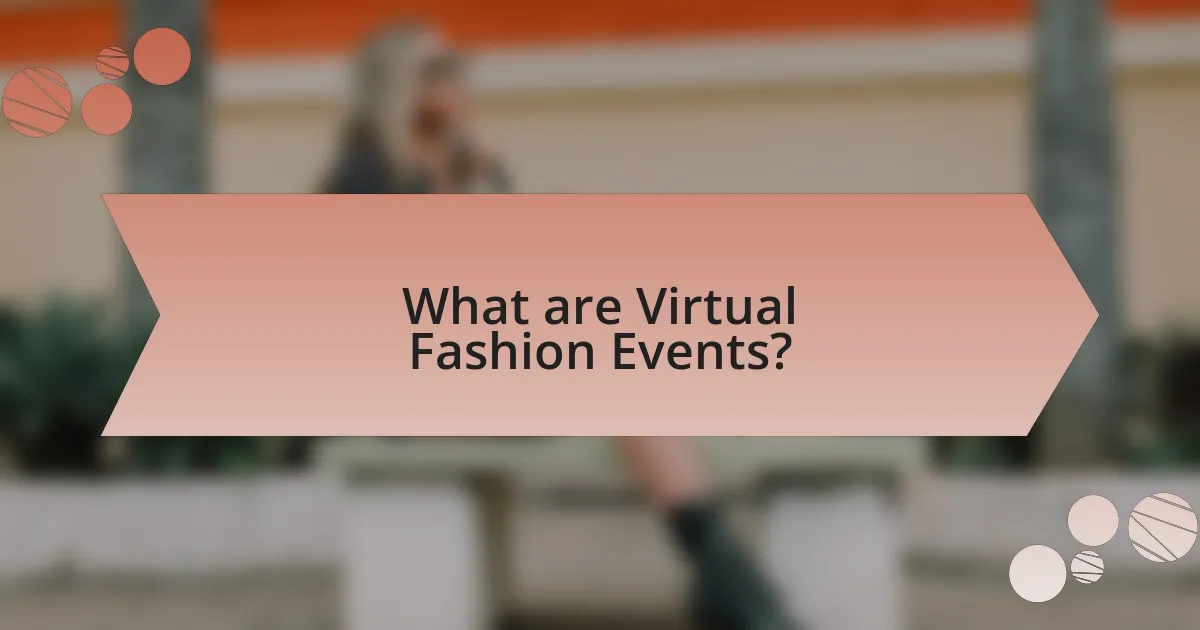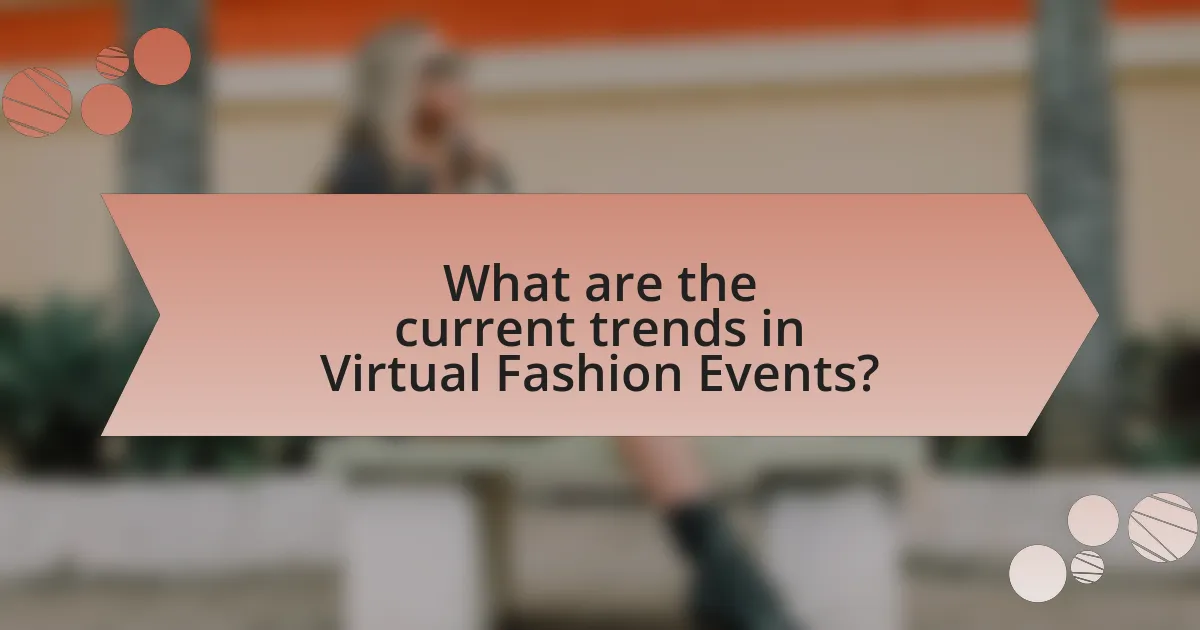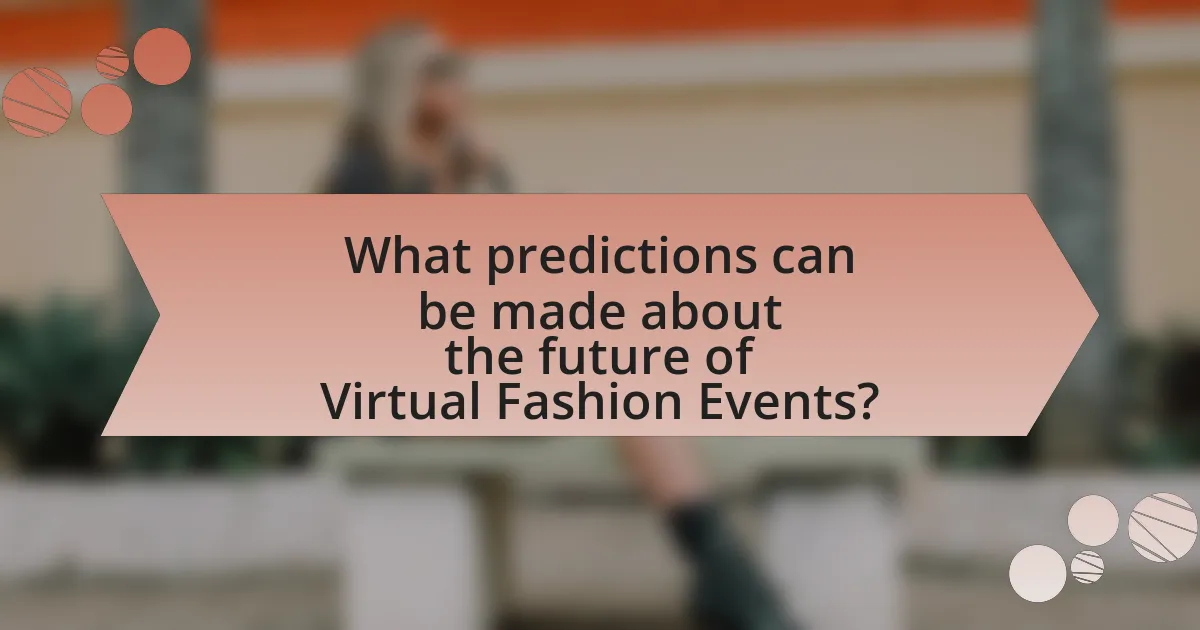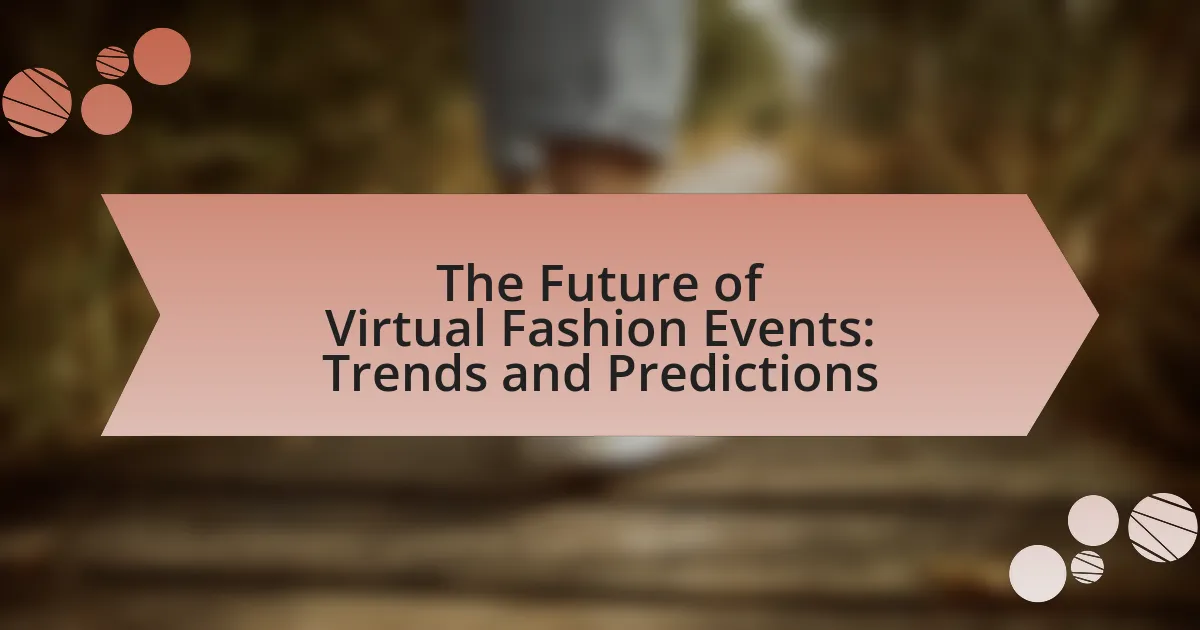Virtual fashion events are online platforms that enable brands to showcase their collections through innovative technologies such as live streaming, augmented reality, and virtual reality. The article explores the differences between virtual and traditional fashion shows, highlighting the increased accessibility and audience engagement that digital formats offer. It discusses the technologies that facilitate these events, the strategies brands use to engage viewers, and the impact of the COVID-19 pandemic on the shift to virtual formats. Additionally, the article examines current trends, the role of social media and influencers, and predictions for the future of virtual fashion events, including the influence of sustainability and emerging technologies. Key metrics for measuring success and best practices for effective marketing are also outlined, providing a comprehensive overview of the evolving landscape of virtual fashion.

What are Virtual Fashion Events?
Virtual fashion events are online platforms where fashion shows, presentations, and exhibitions occur, allowing brands to showcase their collections to a global audience. These events leverage technology such as live streaming, augmented reality, and virtual reality to create immersive experiences that engage viewers. The rise of virtual fashion events has been accelerated by the COVID-19 pandemic, which necessitated a shift from traditional in-person gatherings to digital formats. According to a report by McKinsey & Company, the fashion industry saw a significant increase in digital engagement, with virtual events becoming a key strategy for brands to maintain visibility and connect with consumers.
How do Virtual Fashion Events differ from traditional fashion shows?
Virtual fashion events differ from traditional fashion shows primarily in their format and accessibility. Traditional fashion shows are physical events held in specific locations, often limited to invited guests, while virtual fashion events utilize digital platforms to reach a global audience, allowing anyone with internet access to participate. This shift has been accelerated by advancements in technology, enabling brands to showcase collections through live streams, interactive experiences, and immersive environments. For instance, during the COVID-19 pandemic, many brands transitioned to virtual formats, demonstrating that virtual events can attract larger audiences and provide innovative ways to engage consumers, such as through augmented reality and social media integration.
What technologies enable Virtual Fashion Events?
Virtual fashion events are enabled by technologies such as augmented reality (AR), virtual reality (VR), live streaming, and 3D modeling software. AR enhances the viewer’s experience by overlaying digital elements onto the real world, allowing users to visualize clothing in a more interactive manner. VR creates immersive environments where attendees can explore virtual showrooms and interact with fashion items as if they were physically present. Live streaming technology facilitates real-time broadcasting of fashion shows to a global audience, increasing accessibility and engagement. Additionally, 3D modeling software allows designers to create realistic digital representations of garments, which can be showcased in virtual environments. These technologies collectively transform the traditional fashion event landscape, making it more interactive and accessible.
How do audience engagement strategies vary in Virtual Fashion Events?
Audience engagement strategies in Virtual Fashion Events vary primarily through the use of interactive technologies, personalized content, and community-building initiatives. For instance, platforms often incorporate live polls, Q&A sessions, and chat features to facilitate real-time interaction between designers and attendees, enhancing the overall experience. Additionally, personalized content, such as tailored recommendations based on user preferences, helps to engage viewers more effectively. Community-building initiatives, like social media integration and virtual networking opportunities, further foster a sense of belonging among participants. These strategies are supported by data indicating that events utilizing interactive elements see up to 70% higher engagement rates compared to traditional formats.
Why are Virtual Fashion Events gaining popularity?
Virtual fashion events are gaining popularity due to their ability to reach a global audience and provide immersive experiences. The shift towards digital platforms allows brands to showcase their collections without geographical limitations, significantly increasing viewer engagement. According to a report by McKinsey & Company, the fashion industry saw a 20% increase in online sales during the pandemic, highlighting the effectiveness of virtual formats. Additionally, virtual events often incorporate interactive elements, such as live chats and augmented reality, enhancing viewer participation and creating a more dynamic experience. This combination of accessibility and engagement is driving the trend towards virtual fashion events.
What role does accessibility play in the rise of Virtual Fashion Events?
Accessibility significantly enhances the rise of Virtual Fashion Events by allowing a broader audience to participate regardless of geographical location or physical limitations. This inclusivity is evidenced by the increasing number of attendees at virtual events, which can reach millions, compared to traditional fashion shows that often limit attendance to a select few. For instance, during the COVID-19 pandemic, brands like Balenciaga and Gucci reported substantial increases in viewership for their virtual shows, demonstrating that accessibility directly correlates with audience engagement and brand reach.
How has the COVID-19 pandemic influenced the shift to virtual formats?
The COVID-19 pandemic has significantly accelerated the shift to virtual formats across various sectors, including fashion events. As physical gatherings were restricted due to health concerns, many organizations transitioned to online platforms to maintain engagement and reach wider audiences. For instance, the global fashion industry saw a 93% decline in physical events in 2020, prompting brands to adopt virtual showcases, which allowed them to connect with consumers and industry professionals remotely. This shift not only facilitated immediate adaptation to pandemic-related challenges but also demonstrated the potential for cost-effective and accessible alternatives to traditional in-person events.

What are the current trends in Virtual Fashion Events?
Current trends in virtual fashion events include increased use of augmented reality (AR) and virtual reality (VR) technologies, which enhance user engagement by allowing attendees to experience fashion shows and collections in immersive environments. Additionally, brands are leveraging live streaming and interactive platforms to reach global audiences, with statistics showing that virtual events can attract up to 10 times more viewers than traditional in-person shows. Sustainability is also a key focus, as many designers are showcasing eco-friendly collections and practices during these events, reflecting a growing consumer demand for responsible fashion. Furthermore, collaborations between fashion brands and digital artists are becoming more common, resulting in unique virtual experiences that blend fashion with digital art.
How are brands utilizing social media in Virtual Fashion Events?
Brands are utilizing social media in Virtual Fashion Events by leveraging platforms for live streaming, audience engagement, and real-time interaction. For instance, brands like Balenciaga and Gucci have hosted live-streamed runway shows on Instagram and TikTok, allowing viewers to experience the event as it unfolds. This approach not only broadens their audience reach but also fosters community engagement through features like live comments and reactions. Additionally, brands are using social media to create buzz before events by sharing teasers and behind-the-scenes content, which has been shown to increase viewer anticipation and participation. According to a report by McKinsey, 75% of consumers are more likely to engage with brands that utilize social media effectively during virtual events, highlighting the importance of this strategy in enhancing brand visibility and consumer connection.
What platforms are most effective for hosting Virtual Fashion Events?
The most effective platforms for hosting Virtual Fashion Events include Zoom, Instagram Live, and YouTube. Zoom allows for interactive presentations and real-time engagement, making it suitable for fashion shows and discussions. Instagram Live provides a visually appealing platform for brands to showcase their collections directly to followers, leveraging its large user base. YouTube offers extensive reach and the ability to host pre-recorded content, which can be beneficial for high-quality fashion productions. These platforms have been widely adopted in the fashion industry, as evidenced by numerous successful virtual events during the COVID-19 pandemic, which accelerated the shift towards digital engagement in fashion.
How do influencers impact the success of Virtual Fashion Events?
Influencers significantly enhance the success of Virtual Fashion Events by leveraging their extensive reach and engagement with target audiences. Their ability to create buzz and generate interest leads to increased attendance and participation in these events. For instance, a study by the Digital Marketing Institute found that 49% of consumers depend on influencer recommendations for their purchasing decisions, which directly translates to higher viewer numbers and sales during virtual events. Additionally, influencers often provide authentic content that resonates with their followers, fostering a sense of community and excitement around the event. This engagement not only boosts visibility but also enhances brand credibility, making influencers a crucial element in the overall success of Virtual Fashion Events.
What innovations are shaping the future of Virtual Fashion Events?
Innovations shaping the future of Virtual Fashion Events include augmented reality (AR), artificial intelligence (AI), and blockchain technology. AR enhances user experience by allowing attendees to virtually try on clothing and accessories, creating an interactive shopping experience. AI is utilized for personalized recommendations and trend forecasting, improving engagement and sales. Blockchain technology ensures transparency and authenticity in digital fashion items, addressing issues of ownership and copyright. These innovations collectively enhance the immersive experience, streamline operations, and foster trust in virtual fashion environments.
How is augmented reality being integrated into Virtual Fashion Events?
Augmented reality is being integrated into virtual fashion events by enabling immersive experiences that allow users to interact with digital clothing and accessories in real-time. This technology enhances viewer engagement by allowing participants to visualize how garments would look on them through virtual try-ons, which has been adopted by brands like Gucci and Balenciaga during their online showcases. According to a report by McKinsey & Company, the use of augmented reality in fashion can increase customer engagement by up to 70%, demonstrating its effectiveness in enhancing the virtual shopping experience.
What role does artificial intelligence play in enhancing user experience?
Artificial intelligence significantly enhances user experience by personalizing interactions and streamlining processes. AI algorithms analyze user data to tailor recommendations, ensuring that content and products align with individual preferences. For instance, in virtual fashion events, AI can curate personalized fashion shows based on user interests, leading to increased engagement. Additionally, AI-powered chatbots provide real-time assistance, improving customer service by addressing inquiries instantly. Research from McKinsey indicates that companies utilizing AI for personalization can see a 10-30% increase in customer satisfaction, demonstrating the effectiveness of AI in enhancing user experience.

What predictions can be made about the future of Virtual Fashion Events?
Virtual fashion events are predicted to become increasingly immersive and interactive, leveraging advancements in technology such as augmented reality (AR) and virtual reality (VR). As consumer engagement grows, brands will likely adopt these technologies to create more personalized experiences, allowing attendees to interact with digital garments in real-time. According to a report by McKinsey & Company, the global fashion industry is expected to reach $2.25 trillion by 2025, indicating a significant shift towards digital platforms. This trend suggests that virtual fashion events will not only enhance brand visibility but also expand market reach, as they can attract a global audience without geographical limitations.
How might consumer behavior change in response to Virtual Fashion Events?
Consumer behavior may shift towards increased online engagement and purchasing as a result of Virtual Fashion Events. These events provide immersive experiences that allow consumers to interact with brands and products in innovative ways, such as through virtual try-ons and live-streamed fashion shows. According to a report by McKinsey & Company, 65% of consumers are more likely to purchase items they see in virtual formats, indicating a strong correlation between virtual experiences and buying intent. Additionally, the accessibility of virtual events can attract a broader audience, leading to a diversification of consumer demographics and preferences. This shift suggests that brands may need to adapt their marketing strategies to cater to a more digitally-savvy consumer base that values convenience and interactive experiences.
What emerging technologies could redefine Virtual Fashion Events?
Emerging technologies that could redefine Virtual Fashion Events include augmented reality (AR), virtual reality (VR), artificial intelligence (AI), and blockchain. AR enhances user experience by allowing participants to visualize clothing on themselves in real-time, while VR creates immersive environments for showcasing collections. AI can personalize shopping experiences and streamline inventory management, improving engagement and efficiency. Blockchain ensures transparency in supply chains and authenticity of digital fashion items. These technologies are already being integrated into platforms like Decentraland and The Fabricant, demonstrating their potential to transform the virtual fashion landscape.
How will sustainability trends influence the future of Virtual Fashion Events?
Sustainability trends will significantly shape the future of Virtual Fashion Events by prioritizing eco-friendly practices and reducing carbon footprints. As consumers increasingly demand transparency and ethical practices, virtual fashion events will adopt sustainable technologies, such as digital clothing and virtual showrooms, to minimize waste associated with traditional fashion shows. For instance, the global fashion industry is responsible for 10% of annual carbon emissions, prompting brands to explore virtual platforms that eliminate the need for physical materials and travel. This shift not only aligns with consumer values but also enhances brand reputation and market competitiveness in an eco-conscious landscape.
What challenges do Virtual Fashion Events face moving forward?
Virtual fashion events face several challenges moving forward, including technological limitations, audience engagement, and market saturation. Technological limitations can hinder the quality of virtual experiences, as issues like connectivity and platform capabilities may affect the presentation of fashion shows. Audience engagement remains a critical challenge, as brands must find innovative ways to captivate viewers in a digital environment where attention spans are short. Additionally, market saturation poses a risk, as the increasing number of virtual events may dilute the uniqueness and impact of individual shows, making it harder for brands to stand out. These challenges necessitate strategic adaptations to ensure the continued relevance and success of virtual fashion events.
How can brands overcome technical difficulties in Virtual Fashion Events?
Brands can overcome technical difficulties in Virtual Fashion Events by investing in robust technology infrastructure and conducting thorough pre-event testing. A reliable platform with high bandwidth capabilities ensures smooth streaming and interaction, which is crucial for maintaining audience engagement. Additionally, brands should implement backup systems and have technical support readily available during the event to address any issues that arise in real-time. Research indicates that 70% of virtual event organizers prioritize technology reliability to enhance user experience, highlighting the importance of these measures in ensuring successful events.
What strategies can be implemented to maintain audience interest?
To maintain audience interest in virtual fashion events, interactive elements such as live polls, Q&A sessions, and gamification can be implemented. These strategies engage viewers actively, making them feel involved rather than passive observers. For instance, a study by the Event Marketing Institute found that events incorporating interactive features saw a 70% increase in audience engagement compared to traditional formats. Additionally, utilizing high-quality visuals and storytelling can captivate the audience’s attention, as research indicates that compelling narratives can enhance retention and emotional connection.
What best practices should brands follow for successful Virtual Fashion Events?
Brands should prioritize interactivity, high-quality visuals, and targeted marketing for successful Virtual Fashion Events. Interactivity engages audiences, allowing them to participate through live chats, polls, and Q&A sessions, which can increase viewer retention and satisfaction. High-quality visuals are essential, as they create an immersive experience that reflects the brand’s aesthetic and product quality; studies show that 80% of consumers are more likely to engage with visually appealing content. Targeted marketing ensures that the event reaches the right audience, utilizing data analytics to tailor promotions and maximize attendance. By implementing these best practices, brands can enhance engagement and drive sales during virtual events.
How can brands effectively market their Virtual Fashion Events?
Brands can effectively market their Virtual Fashion Events by leveraging social media platforms, influencer partnerships, and targeted advertising. Social media channels like Instagram and TikTok allow brands to showcase event highlights and engage with audiences through interactive content, which can increase visibility and attendance. Collaborating with influencers who resonate with the target demographic can amplify reach, as influencers often have established trust with their followers. Additionally, utilizing targeted advertising on platforms such as Facebook and Google can ensure that promotional content reaches potential attendees based on their interests and behaviors. According to a report by Statista, 54% of consumers use social media to discover new products, highlighting the importance of these marketing strategies in driving engagement and participation in virtual events.
What metrics should be used to measure the success of Virtual Fashion Events?
To measure the success of Virtual Fashion Events, key metrics include attendee engagement, conversion rates, and social media reach. Attendee engagement can be quantified through metrics such as average viewing time, interaction rates during the event (like Q&A participation), and post-event surveys assessing satisfaction. Conversion rates indicate the percentage of attendees who make purchases or sign up for newsletters, reflecting the event’s effectiveness in driving sales. Social media reach encompasses the number of mentions, shares, and overall engagement on platforms like Instagram and Twitter, providing insight into the event’s visibility and audience interaction. These metrics collectively offer a comprehensive view of the event’s impact and effectiveness in achieving its goals.
